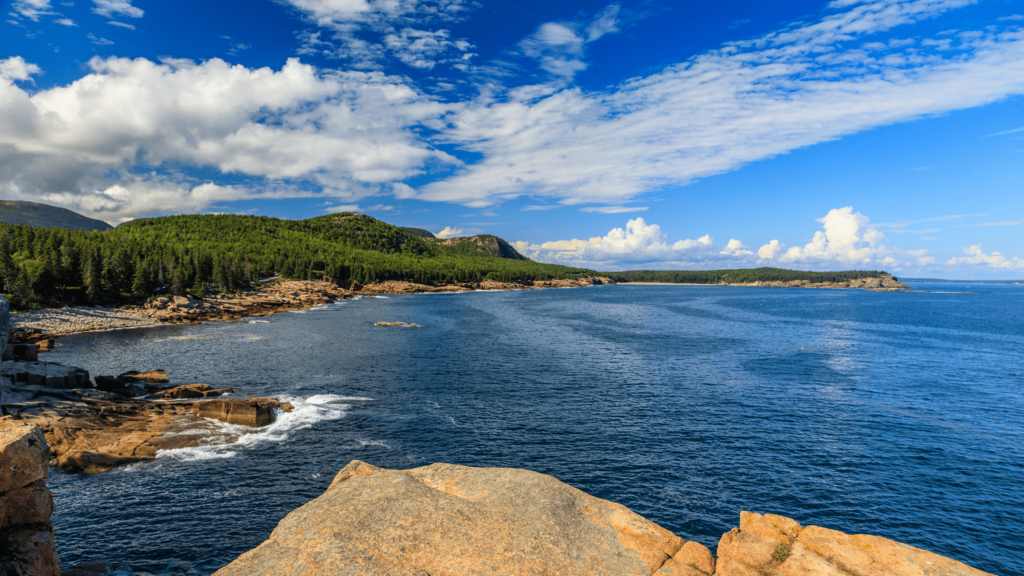The Ultimate Guide: Acadia National Park
Acadia National Park is a National Park located in the state of Maine, on the East Coast of the United States. It covers an area of 49,075 acres. Acadia is home to a diverse range of plant and animal life, including many species of birds, mammals, and reptiles. The park is located on the Atlantic coast, and its landscape includes mountains, forests, lakes, and coastline.
If you are interested in a brief, condensed version of Acadia, you can check out rvResortScouts Acadia listing.
Acadia National Park History
The United States established Acadia in 1916, making it one of the oldest national parks in the country. Originally named, Sieur de Monts National Monument, after the French explorer Samuel de Champlain. The park was later renamed to its current name, Acadia, which is derived from the word “Arcadia,” which means a place of natural beauty and simplicity.
We have preserved many cultural and natural features of Acadia’s rich history for future generations to enjoy. The park is home to many historic sites, including the Jordan Pond House. The house was built in the late 1800s and is now a popular tourist destination.
General Overview
Tourists and outdoor enthusiasts come to Acadia National Park to enjoy its stunning natural beauty and recreational opportunities. The park is open year-round, and visitors can enjoy activities such as hiking, biking, camping, and fishing.
The park is home to a number of hiking trails, including the popular Acadia Mountain Trail and the Beehive Trail. These trails offer breathtaking views of the surrounding landscape and are suitable for hikers of all skill levels. In addition to hiking, the park also offers a number of biking trails, including the Carriage Roads. These were built in the early 1900s and are now a popular destination for cyclists.
The park is also home to a number of lakes and ponds, which are popular for fishing and boating. Jordan Pond, Echo Lake, and Long Pond are among the most popular destinations for these activities.
Getting Orientated
As stated before, Acadia National Park is located on the Atlantic coast of Maine. It is easily accessible from the nearby cities of Bar Harbor and Ellsworth. The park is open year-round, and visitors can enter the park by car, bike, or on foot.
Acadia has several visitor centers and ranger stations, where visitors can get information about the park and its attractions. The Hulls Cove Visitor Center is the main visitor center for the park and is located near the park entrance. You can find other ranger stations and visitor centers throughout the park.
Acadia National Park Essentials
When visiting Acadia Park, there are a few things that visitors should keep in mind to ensure a safe and enjoyable experience.
First, visitors should be prepared for the weather, as temperatures in the park can vary significantly depending on the time of year. In the summer, temperatures can be quite warm, while in the winter, the park can be cold and snowy. Visitors should dress appropriately and bring layers to adjust to changing temperatures.
In addition to clothing, visitors should also bring plenty of water and snacks, as well as a map of the park. A hat, sunscreen, and insect repellent can also be useful. Remember to calculate this based on what types of activities you plan on doing. A person who plans on driving around Acadia will not need as much water as someone hiking through it.
Things You Need to Know
There are a few things that visitors to Acadia National Park should know before they visit.
First, visitors must follow the rules of the park. These include rules around camping, fires, and wildlife. Visitors should familiarize themselves with these rules before visiting the park to ensure that they are in compliance.
Second, visitors should be aware of the potential for wildlife encounters in the park. The park is home to many species of animals. Some of these animals include bears, birds, and moose. Mosquito and tick populations can also be high in the park, particularly in the summer months. Visitors should take precautions to avoid insect bites, such as using insect repellent and wearing long sleeves and pants.
Another thing to be aware of is the park’s transportation system. The park has a number of roads and trails that are open to vehicles, but many areas are only accessible on foot or by bike. Visitors should plan their routes accordingly and be aware of any restrictions.
In addition to the park’s natural attractions, there are also a number of cultural and historic sites located within the park. These include the historic Jordan Pond House, the Schoodic Peninsula, and the Bass Harbor Head Light. Visitors can learn more about the park’s history and cultural significance by visiting these sites and participating in ranger-led programs.
Acadia National Park Travel Tips
- Choose the right time to visit: Acadia is a popular destination, and it can get very busy during peak tourist season. If you want to avoid crowds and enjoy a more peaceful visit, consider coming during the shoulder season (late May through early June or late September through early October). The weather is usually pleasant during these times, and you will have a better chance of finding accommodations and getting a spot at popular attractions.
- Plan your route: Acadia National Park is spread out over several islands and the mainland, so it’s important to plan your route in advance. The park has several main roads that allow you to explore the different areas, including the Park Loop Road, which takes you around the park’s main attractions, and the Cadillac Mountain Summit Road, which takes you to the highest peak on the East Coast.
- Pack for the weather: The weather in Acadia National Park can be unpredictable, so it’s important to pack for all seasons. In the summer, it can be hot and humid, so bring plenty of water and sun protection. In the fall and spring, the weather can be cooler and wet, so bring a raincoat and warm layers. During the winter, we cover the park in snow and the roads can be icy, so make sure you have the right gear for cold weather activities.

Accommodations
There are several options for accommodations in and around Acadia National Park. You can choose from a variety of hotels, motels, bed and breakfast inns, and vacation rentals. Many of these options are located in the nearby towns of Bar Harbor, Southwest Harbor, and Trenton, which are all within a short drive of the park.
If you prefer a more rustic experience, the park also has several campgrounds where you can pitch a tent or park your RV. These campgrounds are located throughout the park and offer amenities like bathrooms, showers, and water fountains.
Backcountry Camping
If you’re looking for an even more rugged and remote camping experience, Acadia National Park also has several backcountry campsites. These campsites are located in the park’s more remote areas, and they are only accessible by foot or boat. They have no amenities, so you will need to bring everything you need with you, including water, food, and shelter.
To camp in the backcountry, you will need to obtain a backcountry camping permit from the park. We offer these permits on a first-come, first-served basis and limit them to help protect the park’s natural resources.
Safety
Acadia National Park is a relatively safe place to visit, but there are a few things you should keep in mind to ensure a safe and enjoyable trip.
- Stay on the trails: The park has over 150 miles of trails, and it’s important to stay on them to protect the park’s natural resources and avoid getting lost. Some trails can be difficult to navigate, so be sure to bring a map and stay alert.
- Watch out for wildlife: Acadia National Park is home to a variety of wildlife, including moose, bears, and coyotes. To avoid danger, it’s important to give these animals plenty of space and not approach them if they feel threatened.. Keep an eye out for wildlife when you’re on the trails and make noise to alert them to your presence.
- Stay hydrated: The weather in the park can be hot and humid, especially in the summer, so it’s important to stay hydrated. Bring plenty of water with you when you’re hiking, and drink frequently to avoid dehydration.
- Protect yourself from the sun: The sun in Acadia National Park can be strong, especially at higher elevations. Be sure to wear sunscreen and a hat to protect your skin, and take breaks in the shade when you need to.
What’s in the Surrounding Area
There is plenty to see and do in the surrounding area. Outside the park, these are three of our favorite attractions.
- Bar Harbor: This charming coastal town is located just a few miles from the park. It is a popular base for visitors to Acadia National Park. It has a variety of restaurants, shops, and activities, including boat tours, kayaking, and whale watching.
- Mount Desert Island: This island, which is home to Acadia, is also home to a number of other attractions, including the beautiful Bass Harbor Head Lighthouse and the charming town of Southwest Harbor.
- Downeast Maine: The region of Downeast Maine is known for its rugged coastline, charming towns, and delicious seafood. It’s a great place to explore if you have some extra time during your visit to Acadia.
Wrap Up On Acadia National Park
Acadia is a beautiful and diverse destination that offers a wide range of recreational and educational opportunities. From its stunning natural beauty and rich history, to its many cultural and historic sites, there is something for everyone to enjoy in this unique and inspiring place. Whether you’re an avid hiker, a nature lover, or just looking to relax and take in the beauty of the park, Acadia National Park is a must-see destination for anyone visiting the state of Maine. So if you’re planning a trip to the East Coast, be sure to add Acadia to your itinerary – you won’t be disappointed.


